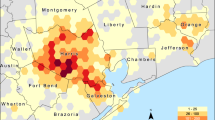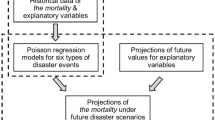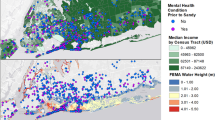Abstract
Flooding could adversely impact human health, but its association with different causes of mortality remains unclear. Here we employed a two-stage time series design, utilizing data from 446,807 deaths that occurred during 2015 to 2019, across 98 counties in North Carolina, United States. We first estimated the associations between flooding exposure and cause-specific mortality at the county level and then aggregated those county-level estimates to determine the overall associations at the state level. Compared with the non-flooding days, the relative risk of deaths associated with flooding exposure was 1.039 (95% confidence interval (CI), 0.998–1.083) (one-day lag), 1.046 (95% CI, 1.003–1.092) (one-day lag) and 1.322 (95% CI, 1.166–1.501) (two-day lag) for total, non-accidental and accidental mortality, respectively. Flooding exposure was also associated with mortality risks for cardiovascular disease, respiratory disease and mental disorders. Older adults aged 65 years old and above experienced a significantly higher risk increase in accidental mortality compared with the rest of the population (those aged 0–64 years old). More total deaths were attributable to non-flash flood compared with flash flood, and more total deaths were attributable to multiple-day flood compared with one-day flood. Compared with one-day flood, multiple-day flood was associated with higher relative risks in total death and all the non-accidental causfes of death (non-accidental, cardiovascular, respiratory and mental disorders). If this association is causal, the estimated flood-attributable mortality would be 201 deaths per year, where multiple-day flood contributed 69% and one-day flood contributed 31% of attributable deaths. Our study may contribute to a better understanding of flooding-related health impacts.
This is a preview of subscription content, access via your institution
Access options
Subscribe to this journal
Receive 12 digital issues and online access to articles
$99.00 per year
only $8.25 per issue
Buy this article
- Purchase on Springer Link
- Instant access to full article PDF
Prices may be subject to local taxes which are calculated during checkout



Similar content being viewed by others
Data availability
Flooding data can be accessed at https://www.ncdc.noaa.gov/stormevents/; daily ambient temperature data can be obtained at https://prism.oregonstate.edu; daily mean precipitation data were obtained from https://www.cpc.ncep.noaa.gov/. Mortality data cannot be shared due to the data confidential limitation but can be obtained from the North Carolina State Center for Health Statistics.
Code availability
All analyses reported in this study used the statistical software R (version 4.2.2). The code used for the main analysis is available at https://github.com/CHENlab-Yale/Flood_mortality_NC/.
References
WMO Atlas of Mortality and Economic Losses from Weather, Climate and Water Extremes (1970–2019) (WMO, 2021); https://library.wmo.int/idurl/4/57564
IPCC Climate Change 2021: The Physical Science Basis (eds Masson-Delmotte, V. et al.) (Cambridge Univ. Press, 2021).
Zhang, J., Xu, W., Liao, X., Zong, S. & Liu, B. Global mortality risk assessment from river flooding under climate change. Environ. Res. Lett. 16, 064036 (2021).
Ebi, K. L. et al. Extreme weather and climate change: population health and health system implications. Annu. Rev. Public Health 42, 293–315 (2021).
Saulnier, D. D., Ribacke, K. B. & von Schreeb, J. No calm after the storm: a systematic review of human health following flood and storm disasters. Prehosp. Disaster Med. 32, 568–579 (2017).
Ashley, S. T. & Ashley, W. S. Flood fatalities in the United States. J. Appl. Meteorol. Climatol. 47, 805–818 (2008).
Vinet, F. et al. Mapping flood-related mortality in the Mediterranean Basin. Results from the MEFF v2.0 DB. Water 11, 2196 (2019).
Han, Z. & Sharif, H. O. Analysis of flood fatalities in the United States, 1959–2019. Water 13, 1871 (2021).
Quist, A. J. L. et al. Hurricane flooding and acute gastrointestinal illness in North Carolina. Sci. Total Environ. 809, 151108 (2022).
Few, R., Ahern, M., Matthies, F. & Kovats, S. Floods, Health and Climate Change: A Strategic Review (Tyndall Centre for Climate Change Research, 2004).
Parks, R. M. et al. Association of tropical cyclones with county-level mortality in the US. JAMA 327, 946–955 (2022).
Ryan, B. et al. Identifying and describing the impact of cyclone, storm and flood related disasters on treatment management, care and exacerbations of non-communicable diseases and the implications for public health. PLoS Curr. Disasters 7, 1–21 (2015).
Nagayoshi, Y. et al. Heart attacks triggered by huge mud slides in mountain regions and severe flooding in inhabited areas. J. Cardiol. 65, 117–120 (2015).
Yan, M. et al. Community-wide mortality rates in Beijing, China, during the July 2012 flood compared with unexposed periods. Epidemiology 31, 319–326 (2020).
Alderman, K., Turner, L. R. & Tong, S. Floods and human health: a systematic review. Environ. Int. 47, 37–47 (2012).
U.S. Billion-Dollar Weather and Climate Disasters 1980–2023 (NOAA NCEI, 2023); https://www.ncei.noaa.gov/access/billions/events.pdf
Tellman, B., Schank, C., Schwarz, B., Howe, P. D. & de Sherbinin, A. Using disaster outcomes to validate components of social vulnerability to floods: flood deaths and property damage across the USA. Sustainability 12, 6006 (2020).
Yan, M. et al. Tropical cyclone exposures and risks of emergency Medicare hospital admission for cardiorespiratory diseases in 175 urban United States counties, 1999–2010. Epidemiology 32, 315–326 (2021).
Makwana, N. Disaster and its impact on mental health: a narrative review. J. Family Med. Prim. Care 8, 3090–3095 (2019).
Bich, T. H., Quang, L. N., Thanh Ha, L. T., Duc Hanh, T. T. & Guha-Sapir, D. Impacts of flood on health: epidemiologic evidence from Hanoi, Vietnam. Glob. Health Action https://doi.org/10.3402/gha.v4i0.6356 (2011).
Tomio, J., Sato, H. & Mizumura, H. Interruption of medication among outpatients with chronic conditions after a flood. Prehosp. Disaster Med. 25, 42–50 (2010).
Jimenez, A. M., Collins, T. W. & Grineski, S. E. Intra-ethnic disparities in respiratory health problems among hispanic residents impacted by a flood. J. Asthma 50, 463–471 (2013).
Mendell, M. J., Mirer, A. G., Cheung, K., Tong, M. & Douwes, J. Respiratory and allergic health effects of dampness, mold, and dampness-related agents: a review of the epidemiologic evidence. Environ. Health Perspect. 119, 748–756 (2011).
Laudan, J., Zöller, G. & Thieken, A. H. Flash floods versus river floods—a comparison of psychological impacts and implications for precautionary behaviour. Nat. Hazards Earth Syst. Sci. 20, 999–1023 (2020).
Storm Data Preparation A12 (National Weather Service, 2021); https://www.nws.noaa.gov/directives/sym/pd01016005curr.pdf
Bhaskaran, K., Gasparrini, A., Hajat, S., Smeeth, L. & Armstrong, B. Time series regression studies in environmental epidemiology. Int. J. Epidemiol. 42, 1187–1195 (2013).
Sera, F. & Gasparrini, A. Extended two-stage designs for environmental research. Environ. Health 21, 41 (2022).
Rai, A., Adeyeye, T., Insaf, T. & Muscatiello, N. Assessing the effect of precipitation on asthma emergency department visits in New York state from 2005 to 2014: a case-crossover study. GeoHealth 7, e2023GH000849 (2023).
Ingole, V., Juvekar, S., Muralidharan, V., Sambhudas, S. & Rocklöv, J. The short-term association of temperature and rainfall with mortality in Vadu Health and Demographic Surveillance System: a population level time series analysis. Glob. Health Action https://doi.org/10.3402/gha.v5i0.19118 (2012).
Armstrong, B. G., Gasparrini, A. & Tobias, A. Conditional Poisson models: a flexible alternative to conditional logistic case cross-over analysis. BMC Med. Res. Method. 14, 122 (2014).
TIGER/Line Shapefiles (US Census Bureau, 2019); https://www.census.gov/geographies/mapping-files/time-series/geo/tiger-line-file.2019.html#list-tab-790442341
Acknowledgements
J.B. was supported by the Li Foundation Climate Change Fellowship Program at the Yale Center on Climate Change and Health.
Author information
Authors and Affiliations
Contributions
J.B. designed the study, implemented analyses and drafted the manuscript; K.C. designed the study, conceived of and supervised the conduct of this study and edited the manuscript. Y.M. and C.L. applied and cleaned the precipitation and temperature data; C.S. contributed to the writing and manuscript revision. All authors approved the final version of this paper.
Corresponding author
Ethics declarations
Competing interests
The authors declare no competing interests.
Peer review
Peer review information
Nature Water thanks the anonymous reviewers for their contribution to the peer review of this work.
Additional information
Publisher’s note Springer Nature remains neutral with regard to jurisdictional claims in published maps and institutional affiliations.
Supplementary information
Supplementary Information
Supplementary Methods, Tables 1–5 and Figs. 1–5.
Rights and permissions
Springer Nature or its licensor (e.g. a society or other partner) holds exclusive rights to this article under a publishing agreement with the author(s) or other rightsholder(s); author self-archiving of the accepted manuscript version of this article is solely governed by the terms of such publishing agreement and applicable law.
About this article
Cite this article
Ban, J., Sutton, C., Ma, Y. et al. Association of flooding exposure with cause-specific mortality in North Carolina, United States. Nat Water 1, 1027–1034 (2023). https://doi.org/10.1038/s44221-023-00167-5
Received:
Accepted:
Published:
Issue Date:
DOI: https://doi.org/10.1038/s44221-023-00167-5



